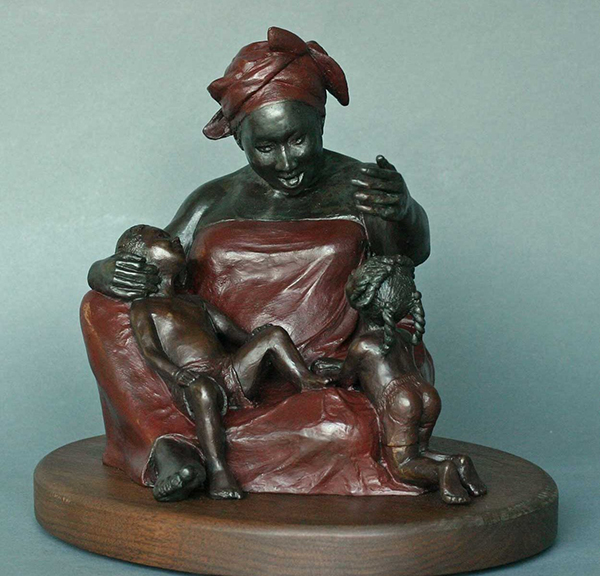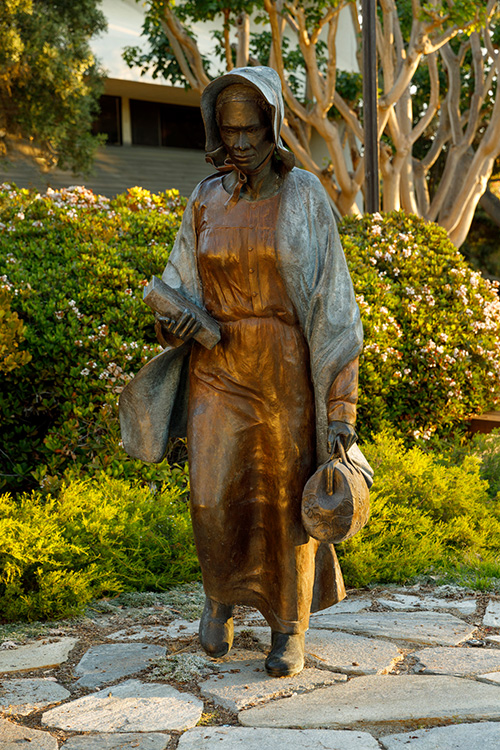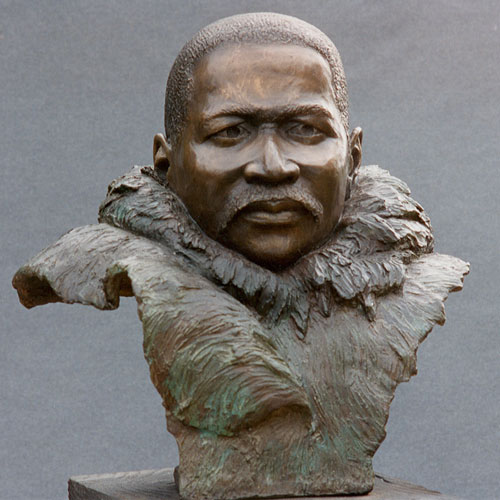Figurative sculptures have become icons for entire cities as well as the basis for colossal statues, but that’s just a hint at the power they contain to inspire audiences across eras. By depicting how real people look, act and appear, figurative sculptures are able to capture a truth about the present that will never translate in the same manner as abstract pieces that are far more open to interpretation.

This power is one that sculptor Manuelita Brown is not only well aware of but also something she considers in an active way. Endowed with an exceptional understanding of universal human experiences that are reflected in her private, corporate, and public commissions, Brown helps viewers relate to the humanity of the individuals that are reflected in her sculptures. That reflection connects those figures to audiences in the present and future.
Brown’s body of work includes figurative pieces, portraits and public art, but the reality is that all of these types of sculptures are designed to provide viewers with a window into themselves. That perspective has allowed her pieces to create a definitive cultural and economic impact on the areas and for the communities where they’ve been installed.
Moving Beyond the Commission Process
The typical request for proposal (RFP) process that sculptors and public artists have to go through can be as onerous as it is irrational. Decisions can be made based on everything except which piece is the best fit for a given location or community. That reality is why sculptors like Brown have cultivated alternative approaches to seeing their vision realized.

“As an example of what this can look like, one of the pieces I decided to do without a specific sponsor was the sculpture of Sojourner Truth,” Brown told The Monumentous. “When I did the maquette, I was responding to an RFP and my methodology was to read several biographies of Sojourner Truth, to get to know her as a person and then decide what I wanted to do to represent her. Most of the sculptures that have been done were of her at the end of her life and the piece that ended up being selected for that RFP was the same. I really felt I was supposed to do a sculpture that depicted her in a much different way though, so I did.”
Brown’s process to make the sculpture a reality was one that involved a social media outreach to enable financial support for the project. However, her efforts also opened up opportunities related to the eventual home of the piece. As the sculpture was being completed, a professor from UC San Diego came by her studio and realized it would be a perfect fit for the campus. He championed the project and got the university involved; they eventually purchased it. The piece is now located on the Thurgood Marshal College Campus at the University of California at San Diego.
The many ways in which such pieces can become part of their communities is evident, but the impact they can enable on both a cultural and economic level is especially relevant in Brown’s work.
How Sculptures Can Change Perceptions and Enable Opportunities
The University of California at San Diego asked Brown to create a sculpture of their mascot, which might seem like an especially simple request for a sculptor. Her approach to creating the piece saw her go beyond that by connecting with students to better understand what type of piece would be most reflective of them. That effort underscores what it can mean when an artist strives to engage with communities on a much deeper level.
Because of that, students and visitors pose with and take photos of the UCSD Triton multiple times a day. A photo of the Triton ended up on all student IDs for multiple years, further highlighting how such pieces can be connected to a community. However, the connection enabled by her eight life size dolphins in pools of water at a shopping center takes this concept to a whole new level.

“One of the most powerful pieces of feedback I’ve received about that piece was from someone who told me that before it was installed, this person couldn’t shop at the center because all the people and noise made them too anxious to be there,” Brown mentioned. “Now this person sits by the dolphin when they feel that way and can actually stay there longer. The sculpture calmed them down, and I think that speaks to how these pieces can change perceptions for audiences and create a whole new sense of a space.”
The dolphins were in part designed to compel shoppers to stop and linger in the area and they’ve been successful in that regard. With the dolphin in the shopping center, children have begun to play in that area and enable engagement from audiences to the point that shop owners didn’t want to see the pieces removed. The shopping center where the dolphins are located was sold not too long ago and the new owners asked tenants about potential changes. Above all else, the one thing they heard was to not take out the dolphin sculptures.
As a further indication of how Brown’s sculptures have become icons for the community, “Encinitas Child” is a sculpture of a southern California beach child who welcomes southbound traffic and pedestrians into downtown Encinitas, CA. The sculpture is featured on a billboard that says “Welcome to Encinitas” along with various other icons of the city. It’s an indication of how the sculpture has become a significant feature in the city.
This type of impact is one that Brown could directly empower, as her contract allows her to sell items associated with her work. Doing so would further highlight the economic and cultural impact of her sculptures in the present, but that impact is just a hint at what they might mean for the future of these communities and beyond.
Communicating with Future Generations

The Riace bronzes were miraculously discovered in the Ionian Sea off the coast of Riace Marina in southern Italy in 1972. The statues have been dated to between 460 and 450 BCE but they depict people that are representative of real individuals, just like Brown’s figurative sculptures. Also just like Brown’s sculptures, they convey something especially profound about those individuals that was as evident to audiences of that era as it is to people in the present. That sense of enabling communication and connection across time is something Brown is focused on.
“I want to be able to communicate with people centuries from now to give them a real sense of who we are as people and how we interact with each other,” Brown said. “It’s one of the reasons that I focus on figurative sculptures. I can’t see someone 100 years from now, but I can create something that tells him or her something about the culture and people now. It can convey what they wear and how they move and what their relationships mean to other people and communities as a whole. I’m very interested in how these pieces will be seen by a culture different from what we have now.”
The permanence of materials like bronze speaks to how sculptors like Brown want to communicate with audiences across the eras. Doing so has opened up considerable economic and cultural opportunities for her and for the communities where her pieces are making an impact in the present and will continue to do so into the far future.
To learn more about the work of Manuelita Brown, visit her site.
